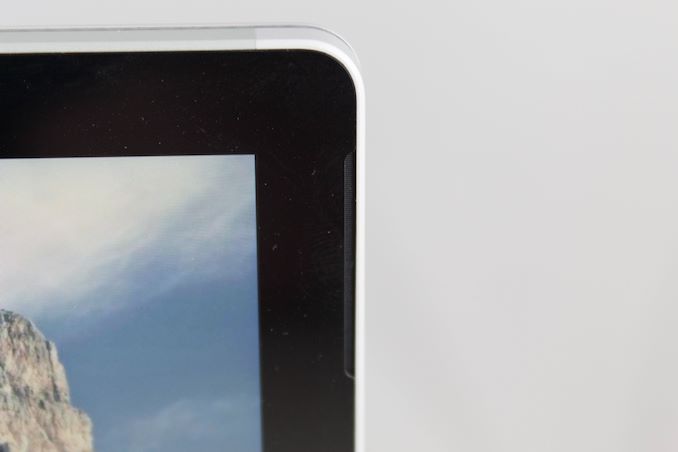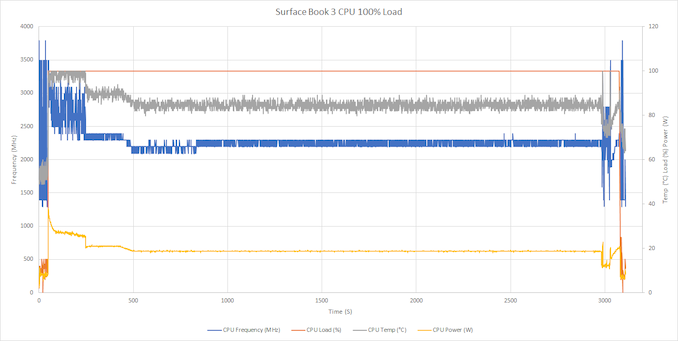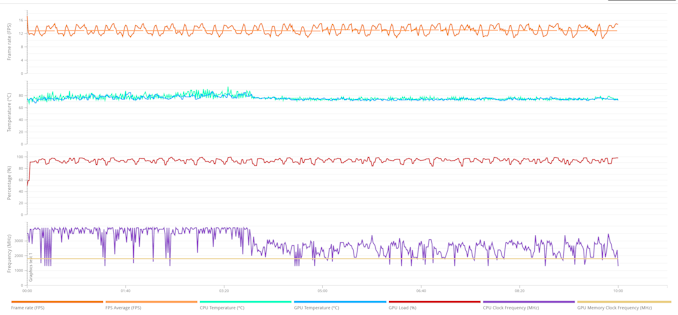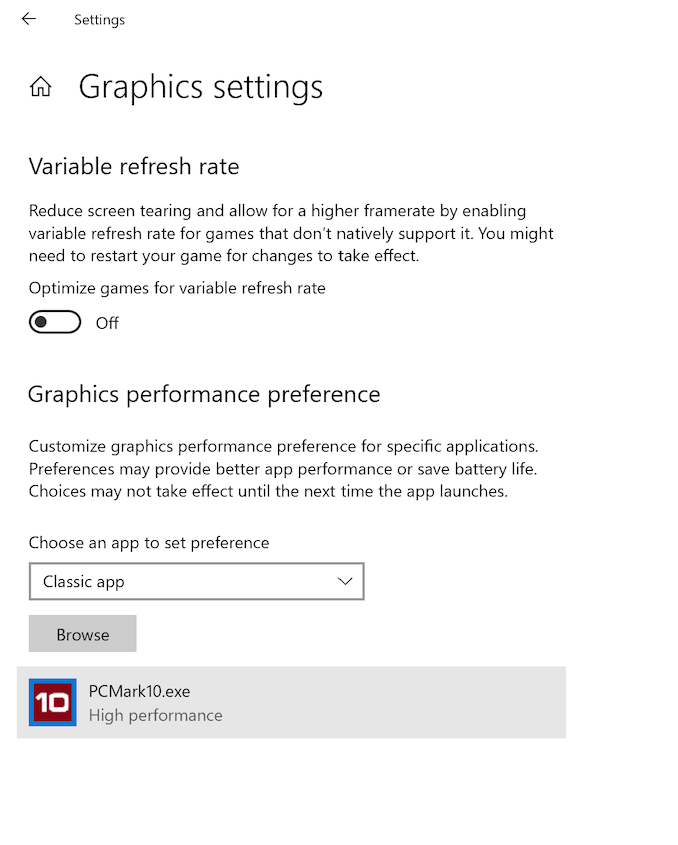The Microsoft Surface Book 3 (15-Inch) Review: A Refreshing Dip Into Ice Lake
by Brett Howse on June 3, 2020 9:00 AM ESTWireless
For the past several generations, Microsoft has leveraged Marvell networking adapters, unless the device had LTE, in which case they tended to use Qualcomm. Unfortunately, both were prone to unreliability and could not keep up with sustained transfer speeds like the latest Intel wireless solutions. Now that Wi-Fi 6 is upon us, the trend seems to be for everyone to use Intel wireless, including the Surface lineup. The Surface Book 3 features the Intel AX201 Wi-Fi 6 network adapter, which is a 2x2:2 design with the full 160 MHz channel width support.

The speeds are fantastic, and Intel has continued offering their very solid drivers too, so reliability has been top-notch. Although competition is always welcome, in the PC space there is really one standout wireless solution, and this is it.
Audio
Microsoft outfits the Surface Book 3 with front-facing stereo speakers featuring Dolby Atmos. As is typical of the Surface speakers, they blend almost seamlessly into the display bezel meaning they are almost invisible to the eye. There are also dual far-field microphones for dictation, or conferencing.
Sound quality of the speakers is excellent, and although they only achieved around 73dB(A) of SPL, the range of the speakers were quite impressive.
Thermals
The two-zone thermals of the Surface Book 3 mean that the temperature of the CPU will not impact the GPU, and vice versa. It also means that Microsoft has more room for a larger GPU, which we’ve seen the results of in our GPU testing. The CPU side with the Core i7-1065G7 has a thermal design of 15 Watts, meaning the processor is designed for a stead-state thermal load of 15 Watts, but with Intel’s aggressive Turbo, processors will draw much more than that for short bursts. On the GPU side, NVIDIA rates the GTX 1660 Ti Max-Q at between 65 and 80 Watts, depending on implementation.
The Surface Book 3 was subjected to a full CPU stress test, while monitoring the frequency and power draw of the processor. Interestingly, the processor very quickly bumps into the 100°C thermal limit, causing the processor to throttle at the start of the test during the PL1 stage of the CPU, which peaks at about 38 Watts maximum and 100°C. When PL1 ends and the processor moves into PL2, the power draw drops to a steady state value of around 19 Watts. So the Surface Book 3 can easily handle the full TDP of the processor, but it does not quite have enough to handle the full limit Microsoft implemented for PL1. This likely means there is not enough heatsink mass to handle the initial burst, although there is enough dissipation to handle the processor under load. As a comparison point, the Surface Laptop 3 with the same processor managed about 43 Watts at PL1 and it never quite reached the 100°C thermal cut-off, and then had a steady state of over 20 Watts. The overall cooling system is unsurprisingly not quite as capable as a more traditional laptop design, at least for the processor.
On the GPU front the Surface Book 3 also performs quite well. Unfortunately, our normal data logging tool was unable to read the GTX 1660 Ti, so instead we ran 20 loops of the 3DMark Fire Strike stress test. The GPU temperatures peaked at around 85° and settled in around 75°, with consistent FPS throughout the 20 loops.
One of the most amazing things about the Surface Book 3 thermals is how much performance there is considering the noise level. At full load after over an hour of use, the Surface Book 3 registered at only 43 dB(A) measured one inch over the trackpad. The tone of the noise is also low enough that it is very easy to live with. Despite not being able to get peak performance out of the CPU for a short window, the cooling system still does a great job and without much noise at all.
Software
One of the best perks of the Surface lineup is that there is no extra software installed to deal with, unless you include the unfortunate fluff that has started shipping directly in Windows. But as Surface is Microsoft’s device lineup, the Surface team also tends to bring new tech to Windows. For the Surface Laptop 3, that is the ability to choose the graphics adapter for each program directly in the Windows Settings. Previously, the NVIDIA Control Panel was required.
Branding of classic applications and UWP applications aside, it is nice to see this brought into Settings since it would be available for all GPU vendors and not require a proprietary tool.
Microsoft also includes the Surface App where you can see details about your device, battery levels of connected Surface peripherals, and get support.
Most laptops ship with some sort of tool for this function now, but the Surface one definitely has more polish than most.















125 Comments
View All Comments
Deicidium369 - Friday, June 5, 2020 - link
I'm saying that Dell builds what sells - they are pretty good at it. I would never buy a Dell desktop or workstation - but for ultrabooks / 2-in-1s and monitors - I am pretty well in the Dell camplmcd - Thursday, June 4, 2020 - link
Oh come on if you spent more than 10 seconds on Dell's website you'd know why.Dell is a corporate company through and through and every one of their laptops supports a dock. Dell docks are 90% TB3 docks. Integrating TB3 with AMD is possible but not easy right now. The turnaround time would be impossible for this laptop launch cycle.
Spunjji - Thursday, June 4, 2020 - link
This reply makes no sense WRT their gaming designs, though.lmcd - Thursday, June 4, 2020 - link
That's a fair critique, but the only gaming designs we've seen are ASUS, no? They were the preferred partner. Don't think AMD has enough "preferred partner" teams to hit up every laptop brand.Retycint - Thursday, June 4, 2020 - link
Did you not read his comment at all? Longer lead times, due to customized components etc. Not to mention the perceived brand differences in average consumers' mindslmcd - Thursday, June 4, 2020 - link
Why did you even reply if you can't read the comment? "And premium laptops have a longer lead time than simpler value and gaming designs."Fataliity - Sunday, June 14, 2020 - link
Renoir only came out 3 months ago. Lead times, especially for redesigning for a new motherboard and all, are about 12 months.Plus Intel has a lead in the size of their motherboard form factors for devices like this. It's not just the processor.
Spunjji - Thursday, June 4, 2020 - link
Microsoft put AMD's last-gen chips in some of their premium devices. It's almost like they already very pointedly developed the ability to second-source even when performance leadership wasn't there...(I can actually understand them not doing so in this specific instance. They barely got their drivers functional for the Intel / Nvidia combo, I don't think they'd have a good time redoing the whole thing for AMD)
We already know that Tiger Lake is a 4-core part at 15W (TDP-down from 28W), so I guess we'll see how things look in a year's time.
Deicidium369 - Friday, June 5, 2020 - link
Would there be significant changes between that APU vs the 4000 series? Can't imagine MS doing it for no reason - but there are pretty long lead times ... that's a bit of a halo (no pun intended)product for MS.Spunjji - Friday, June 5, 2020 - link
I genuinely don't know the answer to that. The desktop models are going to be compatible with the same socket and chipset, so I wouldn't have thought they'd need to do an extensive redesign moving from 3000 to 4000 series APUs - but then 4000 enables the use of things like LPDDR4X, so I may be entirely wrong.It's taken MS long enough to refresh this product that I'm sure you're right about the lead times.